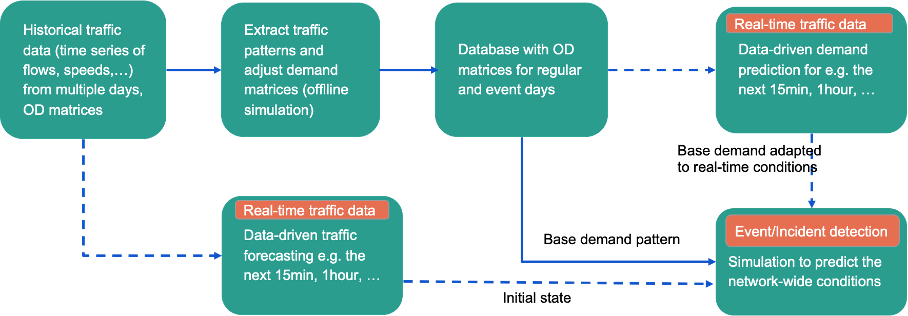- Soluciones
- Innovación
- Software
Obtener Aimsun Next
Usar Aimsun Next
Acerca de Aimsun Next
- Acerca de Aimsun
Simulation-based and data-driven solutions for enhanced real-time multimodal transport management
Published on junio 28, 2023

Athina Tympakianaki
Senior Scientific Researcher
TANGENT is a Horizon 2020 EU-funded project that develops tools for optimising multimodal transport. TANGENT not only provides precise knowledge of how many travellers are moving from A to B via which transport modes, but also supports mobility pattern management. Mobility pattern management includes the implementation and integration of innovative mobility solutions, services, and business models, including cooperative incident management between different transport actors (operators, policy-makers, etc.), tools dealing with connected and automated transport, etc.
Technologies developed within TANGENT focus on:
• Data gathering and harmonisationfrom intermodal mobility and sensors, enabling semantic data interoperability across modes and stakeholders.
• Travel behaviour modelling, describing how individual needs, preferences and sentiments affect decisions under different circumstances, unexpected events, and system disruptions.
• Traffic network prediction & simulation modelsto infer a network’s future traffic state by predicting multimodal travel demand and supply, and the mobility parameters for different time horizons.
• Transport network optimisation, by using the traffic’s current and future status and based on artificial intelligence, the system can determine the best actions to improve traffic operations.
How can cities and authorities apply these developments?
TANGENT proposes a suite of services that can assist transport authorities and operators in applying coordinated traffic and transport network management. The following three types of intervention will be applied to case studies in Athens, Greater Manchester, Lisbon and Rennes:
1. Enhancing information for centralized multimodal transport management, by integrating information from all transport modes (public and private stakeholders). This information can be accessed by transport operators, service provides and transport users through a dashboard and APIs.
2. Improved real-time traffic management. The TANGENTsolutions will provide recommendations at an operational/tactical level to transport operators, optimising the overall transport network operations on a day-to-day basis.
3. Transport network optimisationto support decision-makers in producing policies or response plans to optimise the performance of the network, including dynamic transport network management and transport supply optimisation.
What questions can cities address with the proposed traffic and transport management services?
The developments mentioned above can address various transport mobility related questions, such as:
- How many buses are needed to serve the increased demand after a football match?
- Which are the best routes that drivers can take during work zones on a specific road to reduce their delays and increase safety?
- How can we synchronize public transport lines with on-demand services to facilitate passengers’ mobility needs and accessibility?
- How can traffic be diverted in case of an incident without affecting the surrounding streets?
- Could congestion pricing alleviate traffic in the city?
What tools are used to derive the solutions for more efficient transport management?
A key tool in real-time traffic management is traffic simulation. In addition, the increasing availability of data and artificial intelligence techniques also allow for the development of data-driven solutions.
Both data and simulation provide valuable assistance in the decision-making process for a coordinated multimodal transport management by providing information related to people’s mobility patterns (demand) as well as the current and future traffic conditions (supply).
Simulationis used to replicate, optimise and assess the impact of different transport management strategies before deploying them in real life; these simulations can be configured based on historical information, such as data from past sport events, road accidents or different demand levels. Simulation can capture the demand and supply interactions within the transport ecosystem, enabling the prediction of the conditions across the whole network and evaluation of different congestion mitigation plans, in a proactive manner.
Traffic conditions can be also predicted in real time with data-drivensolutions, using Artificial Intelligence and Machine Learning techniques.
The approach you choose depends on the scope of application as well as the data availability and quality. For instance, where authorities need to predict the network conditions at locations for which real life traffic observations are not available, simulation models are the best option.
How are the different approaches linked together?
Real-time Intelligent Transport Systems (ITS) require the use of simulators to test response plans for traffic control centres and optimise how they can swiftly react to an unplanned event or network disturbance.
The Aimsun team contributes to the TANGENT solutions for enhancing real-time multimodal transport, by developing and integrating different demand and supply estimation and prediction methods into the traffic simulation environment. This extends the simulation software’s modelling capabilities with data-driven models for more efficient and reliable performance. More specifically, the main contribution focuses on enhancing the state-of-the-art demand estimation and prediction methods. Demand estimation refers to the process of calibrating/adjusting, offline, the Origin-Destination (OD) trip matrices of a given transport model, usually using simulation-based approaches. The estimation of dynamic OD matrices becomes very complex for large-scale congested networks, due to insufficient information for capturing the relationship between the OD flows and available traffic measurements.
In TANGENTwe try to improve the performance and quality of the solution of state-of-the-art demand estimation algorithms, while on the demand prediction (for online applications) we are developing innovative data-driven methods based on Deep Learning techniques.
The figure below shows the workflow between the demand and supply models with the simulation environment. The components of the framework included:
- Data collection and preparation of the information that is fed to the demand and supply models.
- Data-driven traffic predictions are performed as real-time data become available.
- Offline demand calibration to replicate the real traffic patterns as realistically as possible. A database can be created with different demands corresponding to various historical traffic patterns, for instance, days with normal congestion and days with sport events. The generated demands are, in turn, used as base input to simulation models for predicting the network-wide traffic conditions and/or assessing the consequences of activating a given response plan under specific circumstances.
- Data-driven models for predicting the future demand (e.g., for the next hour) adapted to real-time traffic conditions can be built based on information related to the current network supply (traffic measurements, incident detection information) and available base demands.
- Simulation predictions for the network-wide conditions can be then performed, within a real-time traffic management framework, that is enhanced by receiving as input for the predicted traffic state and demand.
- Detection of incidents and prediction of their duration are represented and replicated in the simulation predictions as well.

We look forward to sharing results and insights from the applications of the developed technologies to the TANGENT cities soon!

